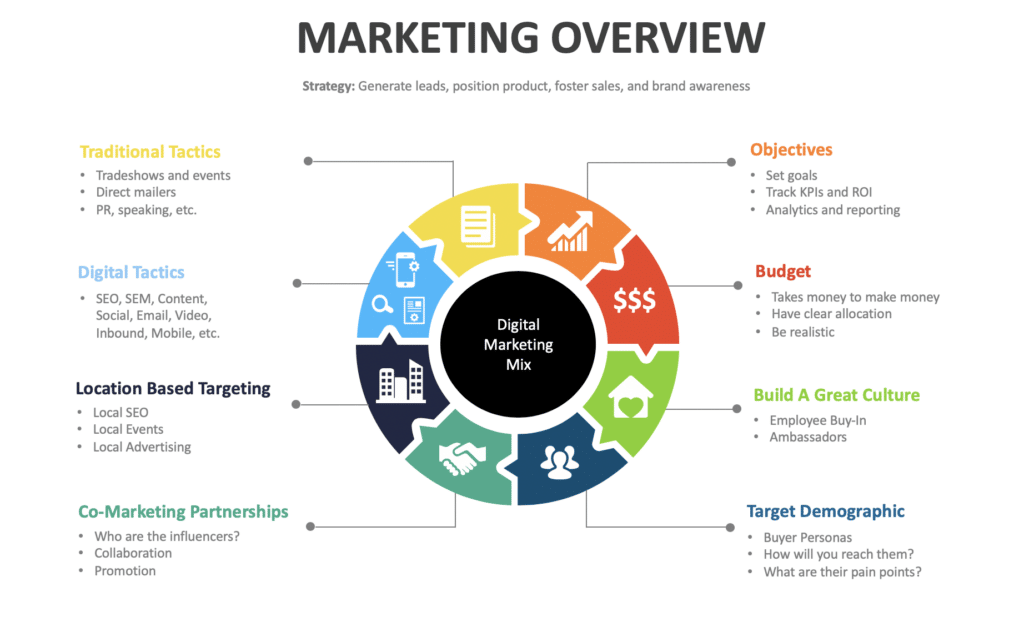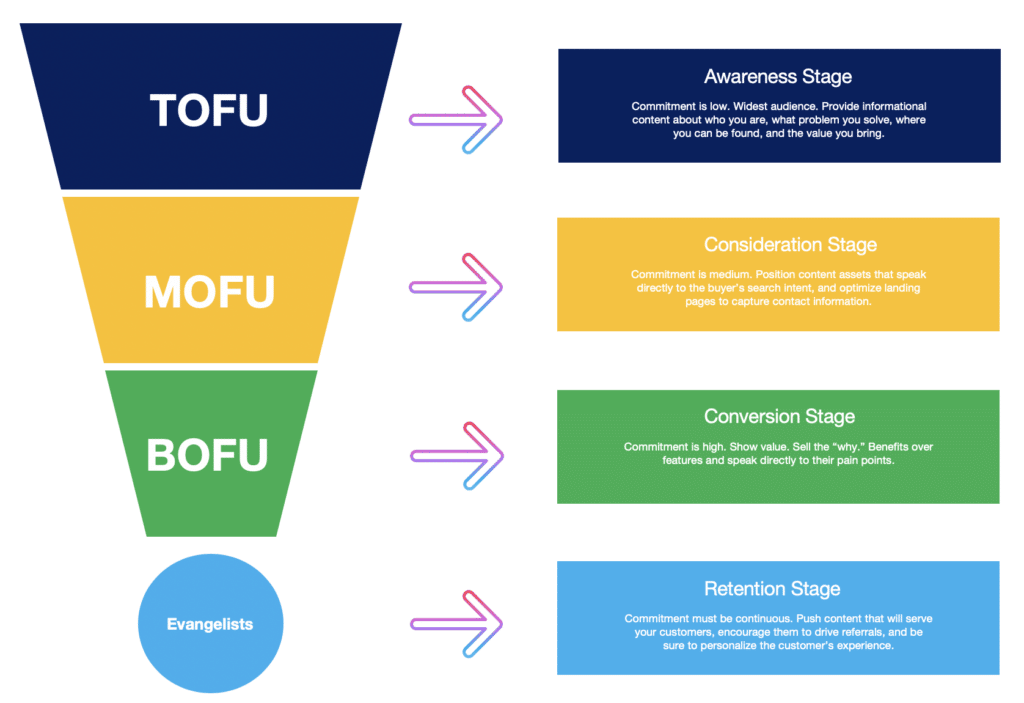Mapping out the buyer journey is key to marketing success. Being able to visualize their lifecycle stages, how marketing efforts will attract and influence potential buyers to become customers and contribute to retention will help with measurability.
More specifically, having a marketing funnel to align with your lead generation efforts is a great way to learn:
- What channels your hottest leads come in from
- Where in the funnel most of your leads get stuck
- Which content assets you use during each phase of your funnel that drive the highest engagement into sales accepted leads and contribute to retention

Your marketing funnel should be there to visually serve your overall lead generation and sales strategy — meaning that you are going to use it to foster both. Additionally, use it as a way to illustrate what you believe the buyer journey will look like as you push to gain traction.

Next up, here’s why it’s so important to have a funnel in place to convert leads, increase sales enablement, and drive actual sales:
- 68% of companies have not identified or attempted to measure a sales funnel, and the same survey showed that a whopping 79% of marketing leads are never converted into sales.
- 69% of marketers feel their top priority should be converting leads into customers.
- Nurtured leads make 47% larger purchases than non-nurtured leads.
- 96% of visitors to your website aren’t ready to buy anything yet.
- Leads will be 70% down the funnel by the time they are ready to talk to a sales rep, and content plays a huge role in this.
That being said, here are the steps you should take when it comes to building a marketing funnel for lead generation:
Top of the Funnel (TOFU)
This part of the funnel narrows down to awareness and pushing your advertising, content, and organic assets to meet your target audience wherever they are online. At this phase, it is safe to say that your primary goal is to build awareness and position thought leadership content that will drive traffic back to your website.

There is a broader range of tactics here to reach your target audience and at this stage, not all of the leads who come in are going to be moving their way down the funnel.
Tactics for this phase include executions such as:
- Display ads
- PPC ads
- Cold email outreaches
- SEO
- Blog posts
- PR
- Social media
- Building out targeted landing pages
In this stage, your target audience has a pain point that exists and they are looking for a solution, but nowhere ready to convert into a paying customer. More specifically, here’s what to expect:
- You will generate a ton of leads
- Not all of these leads will become MQLs
- Not all of these leads will become SQLs and SALs either
- You’ll need to build trust and credibility through great content
- You’ll need to be transparent about how your product/service solves their problems
- You’ll want to segment these leads as soon they come in by source
- Attach lead scoring and nurture leads that move down the funnel
- Disqualify the leads that aren’t a good fit
Middle of the Funnel (MOFU)
At this phase of the funnel, you’re still pushing the same type of tactics as you would be with TOFU, but you are more specific, based on the interests and engagement of your leads. The audience size will narrow at this stage, allowing you to customize the journey as much as possible.

To support lead generation efforts with the right persona, additional tactics should include:
- Continual optimization of ads, content, and landing pages
- Push CRO (conversion-rate-optimization) on landing pages to increase visit to lead %
- Keep testing and don’t worry about “perfecting” every implementation because it’s more important to make progress
- Collect data and use it to your advantage with changes that might be needed to make improvements
- Nurture with content more specific to your products/services
- Use email marketing as a key asset at this stage
The goal for this lifecycle stage is to clearly segment the leads you have collected into their own buckets and workflows. As you do this, you will also be able to communicate to each segmented group based on their behavior, further providing content they want to consume. In fact, 96% of B2B marketers say segmentation is the most valuable method for improving conversion rates. The two buckets to look at are MQLs and SQLs/SALs.
MQLs will continue to be nurtured by marketing until they hit a specific threshold with lead scoring. At that juncture, if leads still haven’t converted into becoming SQLs/SALs, they can be disqualified or dropped into a “newsletter” bucket to still receive communication, but not pushed any further down the funnel.
As for SQLs/SALs, it’s important to understand what triggered leads to take the next steps and how you can replicate this with other leads that have not yet converted over. Make sure you are tracking the qualification rate and then the close rate thereafter.
Bottom of the Funnel (BOFU)
Did you know that companies with mature lead generation and management practices have a 9.3% higher sales quota achievement rate? As nurtured leads become SQLs/SALs and then closed as new sales, you should be able to also look at the ROI of your marketing efforts. Know that. This is one of the most important aspects of being able to clearly see the top-performing channels by conversion and LTV. Looking at both metrics will enable you to dedicate more marketing dollars to the channels that perform the best.

Once revenue starts coming in the door, it’s also important to look at retention and how you can begin to develop a deeper connection with your customers. Doing so will allow you to segment based on the customers who are your raving fans from the customers who are less likely to recommend your product/services to their colleagues.

Therefore, make sure that you have the following nailed down:
- A feedback loop between sales and marketing on lead quality
- Understand the top reasons people do not buy
- Understand the top reasons why people buy
- Onboarding needs to be seamless and engaging
- Use NPS and thresholds to segment your customers and communicate accordingly to each segment
- Look for upsell opportunities where it makes sense
- Push for case studies and testimonials among your raving fans
- Continue testing as much as possible
Wrapping It Up
As you put together your own funnel, know that the goal isn’t to just generate leads and provide a positive ROI for your company, but that you are able to leverage it as a way to gain internal buy-in between marketing and sales. Also make sure that you track all of your efforts with a data-backed way of reporting, seeing exactly what works.
As you discover the avenues that work the best, begin to optimize them as much as possible so you’ll be able to see which marketing channels drive the best results at the lowest cost. On the other hand, you’ll also be able to attach a baseline dollar amount to how much you’re willing to pay for a lead. This could serve as the financial model you can align with your funnel.






6 Responses